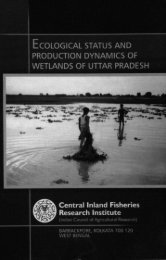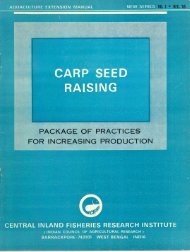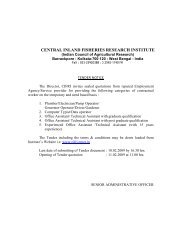Carp production using domestic sewage. - Central Inland Fisheries ...
Carp production using domestic sewage. - Central Inland Fisheries ...
Carp production using domestic sewage. - Central Inland Fisheries ...
You also want an ePaper? Increase the reach of your titles
YUMPU automatically turns print PDFs into web optimized ePapers that Google loves.
PACKAGE OF PRACTICES FOR USING DOMESTIC SEWAGE<br />
IN CARP PRODUCTION<br />
Apurba Ghosh, S. K. Saha, A. K. Roy & P. K. Chakrabarti<br />
1. INTRODUCTION<br />
Waste water produced in a community is looked upon today as the residue of<br />
resources that the community has metabolised. The approach towards waste water<br />
disposal should be utilization of this residue with the concept of their reuse or recycle<br />
through an ecologically balanced system involving mainly aquaculture and agriculture.<br />
The utility of <strong>sewage</strong> effluent to enhance fertility of freshwater ponds has long been<br />
known in many countries of the world. The'average annual <strong>production</strong> of carps from<br />
<strong>sewage</strong> enriched waters in Germany, Rumania, Poland, Hungary, Israel, China and<br />
Java is estimated to vary between 3 and 4.5 tonnesjha.<br />
In India, there are over l32 <strong>sewage</strong>-fed fish farms covering an area of 12,000<br />
hectares and almost all of them are fed with raw <strong>sewage</strong> for fertilization. The Vidyadhari<br />
<strong>sewage</strong>-fed fisheries near Calcutta is an example where farmers have taken full<br />
advantage of <strong>sewage</strong> disposal system of Calcutta Corporation for developing fish cultture<br />
of the area. The annual yield from these fisheries is about 1,258 kgjha. Raw<br />
<strong>sewage</strong> is inimical to fish life for high values of BOD, OC, CO~, NHil, H2S, bacterial<br />
load and negative oxygen value. The high manurial capacity combined with the potentiality<br />
to serve as an additional source of water for maintaining desired depth of<br />
fish pond for culture, particuJarly during dry seasons, are added advantages of <strong>using</strong><br />
such waste waters for fish culture. For the last few years investigations on <strong>sewage</strong><br />
fed fisheries have enabled CIFRI to develop technologies for judicious utilization<br />
of <strong>sewage</strong> effluent through fish culture without any other additional nutritional inputs<br />
like, feed and fertilizer commonly used in freshwater aquaculture.<br />
2. CHARACTERISTICS OF SEWAGE<br />
Domestic <strong>sewage</strong> basically contains wastes from toilets, bathrooms, kitchens and<br />
other house-hold washings together mixed up with trade water, ground water, storm<br />
water, etc. Although there are considerable similarities in the basic constituents,<br />
1













